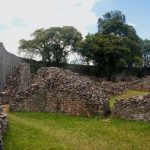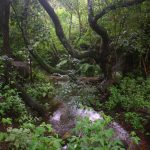TREE LIFE
March and April 2009
MASHONALAND CALENDAR
Sunday 15 March 2009: Rolf Chenaux-Repond has kindly agreed to host our outing this month at his beautiful property, in Sentosa, which we last visited on 26 November 2005.
We will meet as usual at 0930 hours. Please bring a chair and your lunch and cooler bag.
MATABELELAND CALENDAR
Please contact Jean Wiley or Gill Short for details of the next Matabeleland function.
NOTICE OF ANNUAL GENERAL MEETING
Notice is hereby given that the 59th Annual General Meeting of the Tree Society of Zimbabwe will be held on Sunday, 17 May 2009 at 9.30 a.m. The venue is still to be confirmed and will be announced in a later Tree Life.
Any proposals/resolutions and nominations for office bearers should be forwarded to P.O. Box A723, Avondale, Harare by Monday 11 May if possible, although proposals and nominations will be accepted from the floor.
AGENDA
1. Notice convening the meeting
2. Apologies
3. Minutes of the 58th A.G.M.
4. Matters Arising
5. Chairman’s Report
6. Treasurer’s Report
7. Election of Committee Members
8. Any Other Business
SUBSCRIPTIONS: A REMINDER
The subscription for the 12 months beginning 1 April 2009 will be US$5, which must be paid in cash.
The subscription will be the same whether or not a Tree Life is sent by email or whether a hard copy is produced. However, we intend to reduce the number of hard copies and no new applications for hard copies will be entertained.
The subscription may be paid in the following ways:
1. At any outing;
2. To the Treasurer, Terry Fallon, at 285 Samora Machel Avenue;
3. To me, Mark Hyde, at 29 Harry Pichanick Drive, Alexandra Park;
4. To any other Committee member.
Receipts can only be issued at the time of payment if payment is made directly to the Treasurer, who holds the receipt book, but receipts are created in all cases and if anyone wishes to have a copy of their receipt, please ask at time of payment or contact Terry Fallon.
GREYSTONE PARK NATURE PRESERVE Sunday, 16 November 2008
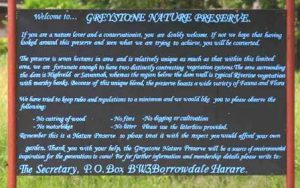
Greystone Nature Reserve. Photo: Burt Wursten. Source: Flora of Zimbabwe
Twelve members gathered in the car park at Greystone Park Nature Preserve on a bright, sunny and already warm morning in November, with a strong hint of the heat to come. Offered the choice between walking in open country round the dam or entering the somewhat shadier area alongside the riverine forest, the latter course was rapidly agreed upon.
The Tree Society has used the Preserve for its Saturday afternoon outings for many years, but I don’t think we have ever had a main outing here before and consequently the area was new to some members.
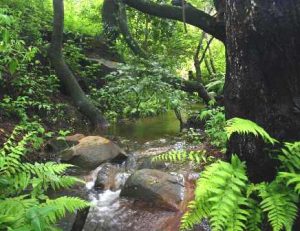
View of ferns in the riverine vegetation. Greystone Nature Reserve. Photo: Burt Wursten. Source: Flora of Zimbabwe
There are various different habitats at the Preserve; on this outing we only really looked at the riverine area and that’s the area we will discuss in this article.
Below the dam wall is an extensive area of thick shady riverine forest. Water flows constantly, even in the dry season, presumably from overflow or leaks from the dam, and this flow results in a very interesting moist environment with evergreen trees and shrubs, ferns and other shade-loving species.
A further, very potent, influence is that the valley in which the Preserve lies is quite narrow and is surrounded closely by gardens, thus allowing many exotic species to extend themselves into the Preserve.
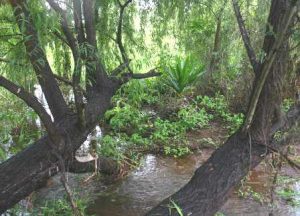
Stream below the dam, in very wet condition. One of the possibly naturalised specimens of Dracaena steudneri is visible in the picture. Photo: Burt Wursten. Source: Flora of Zimbabwe
Just to add to the complications, a number of species have also been planted. The mixture of the exotic, the truly native and the planted makes for some challenging identification problems in which nothing can be taken for granted.
The main native trees in the riverine forest are:
Celtis africana (White stinkwood)
Combretum erythrophyllum (River combretum)
Ficus sur (Cape fig)
Morella serrata (Lance-leaved waxberry). This is a rather local species, but is certainly abundant here.
Rhamnus prinoides (Shiny leaf)
Syzygium cordatum (Waterberry)
In addition, there are a significant component of exotics:
Acrocarpus fraxinifolius (Kenya coffee shade tree)
Fraxinus cf. americanus (American ash)
Homalanthus populifolius (Queensland poplar)
Jacaranda mimosifolia (Jacaranda)
Ligustrum lucidum (Glossy privet)
Michelia champaca (Orange magnolia)
Populus × canescens (Grey poplar)
Populus deltoides (Match poplar). A number of specimens have established themselves at the edge of the riverine zone, presumably from some very large planted trees nearby.
Prunus cerasoides (Himalayan flowering cherry)
Salix babylonica (Weeping willow). Some very large trees of this damp-loving species.
Toona ciliata (Cedrela)
The Michelia, a close relative of the Magnolia, is a most unusual escape in southern Africa. A number of trees have survived here for many years now. Some trees were in flower and the orange flowers at the top of the canopy could be seen from the dam wall.
This strange partly exotic / partly native forest is not unusual around Harare in damp areas. A debate took place as to whether this invasion of exotics was desirable or not. I am actually not particularly a purist on this subject; certainly at Greystone, there is great diversity of species, with no one exotic dominating. In other words, biodiversity remains high.
One new (to me) exotic species seen was the Virginia creeper, Parthenocissus quinquefolia, climbing amongst the riverine vegetation.
All in all, it was an interesting walk with interesting discussions about the plants seen.
As an aside, a list of plant species recorded from Greystone Park may be found on the Zimbabwe flora website at:
https://www.zimbabweflora.co.zw/speciesdata/
The site is still incomplete in many ways. Additional records would be very welcome.
-Mark Hyde
NATURAL RESOURCES LINK TO THE ECONOMY
It is sad to note how, with the situation in Zimbabwe over the last few years, the natural resources have been so severely punished and plundered. It was very interesting and equally sad for me to see an article I recently read locally in Maumee, where I live, about how the economic downturn here has resulted in an exponential growth in the number of cases resulting from some form of plundering of natural resources. It varies from poaching mushrooms and cutting down trees for firewood in the Oak openings region (I wrote about it some time back) to my very own backyard. The article below involves a trophy-size deer that regularly fed on the pear tree in our backyard. It shows that even though we are far apart, we face similar things. I guess the difference is that here they get caught – Occasionally!
Article: Two Toledo men have been charged with a laundry-list of violations in four area municipal courts in connection with the poaching last month of a well-recognized white-tailed deer in Side Cut Metropark.
The deer—a large-antlered, 15-point buck known to some Side Cut fans as Big Boy and to others as Stickers—was probably killed in the early hours of October 9, according to Steve Thomson, a wildlife investigator for Ohio Wildlife District 2. He added that a state wildlife biologist aged the deer at 8 1/2 to 9 1/2 years old—very old for a deer. “Few deer make it to 4 1/2, let alone 8 1/2 or more,” Thomson said. “His teeth were worn down pretty good.” The buck’s great antler size, moreover, puts it in a special restitution class if the men charged in the case are convicted.
Trophy-size bucks command the highest figures, largely because of the eager market for huge sets of antlers, Thomson said. “Any [commercial] propagator could sell such antlers [from a captive-raised buck] for $10,000,” the investigator said.
[The above contribution comes from Paul Nel, an overseas member of the Society who now lives in the US – in Maumee, Ohio.]


